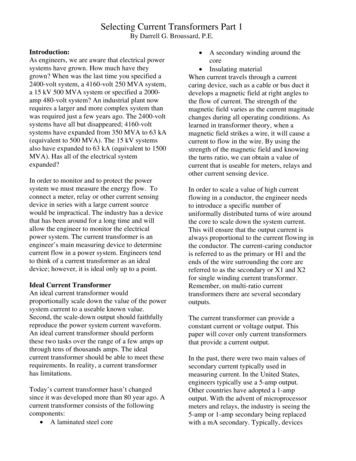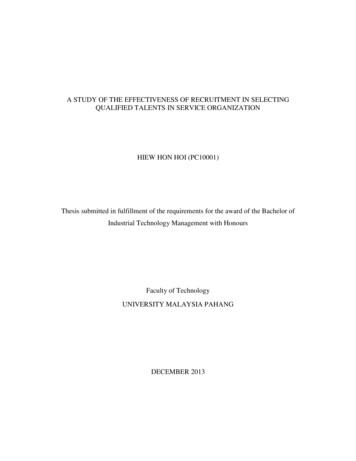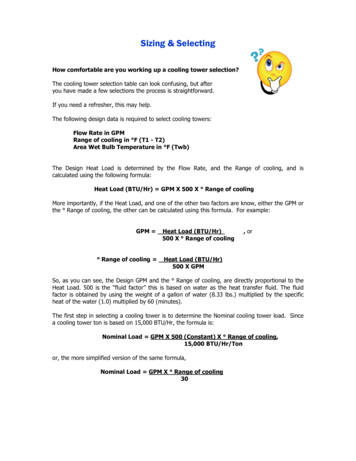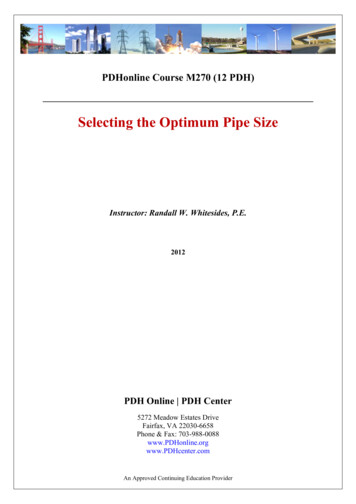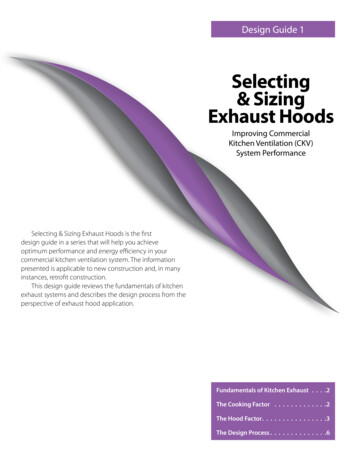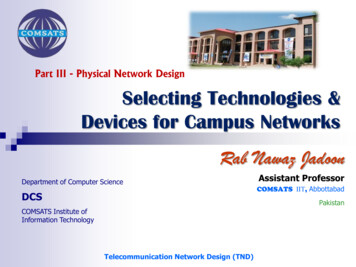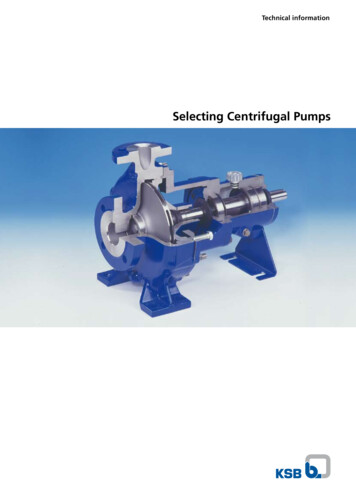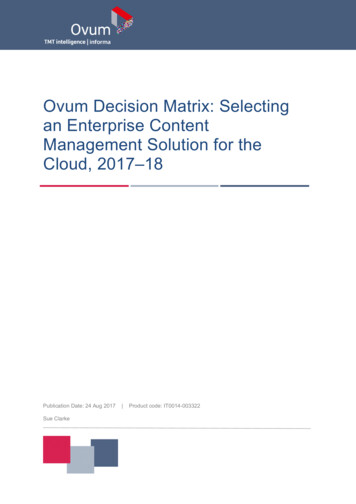
Transcription
Ovum Decision Matrix: Selectingan Enterprise ContentManagement Solution for theCloud, 2017–18Publication Date: 24 Aug 2017Sue Clarke Product code: IT0014-003322
Ovum Decision Matrix: Selecting an Enterprise Content Management Solution for the Cloud, 2017–18SummaryCatalystContent is at the center of digital transformation, and this is driving an evolution in enterprise contentmanagement (ECM) as vendors adapt their products to help enterprises better manage their contentand use it to gain valuable insights. Enterprises need to change the way in which they procure andconsume ECM to take advantage of this evolution. In the last ECM, Ovum Decision Matrix, Selectingan Enterprise Content Management Solution, 2015–16, we spoke about how the large ECM suiteswere beginning to be broken down into solutions that target specific areas of functionality. Thissolutions-based approach to ECM is continuing, and an important element of this is the cloud, whichis allowing ECM to become a services-oriented technology where enterprises can use cloud-basedcontent services to add extra capabilities to existing ECM investments. Most ECM vendors now offercomplete cloud-based ECM solutions, enabling enterprises to move the management of content to thecloud. Enterprises should consider the cloud as an alternative to on-premises ECM. Even if there areno immediate plans to migrate, the next iteration of ECM should result in a platform that can be easilymigrated to the cloud.Ovum viewAn important element of digital transformation is managing the lifecycle of content. Enterprises shouldat the very least consider whether implementing ECM in the cloud is a viable option. Cloud is animportant element of digital transformation, and it addresses two major requirements of enterprises:the need for cost-effective ECM solutions, and ensuring content is secure. ECM platforms havebecome complex and expensive to implement. Eliminating the need for hardware and infrastructure,ECM in the cloud removes much of the complexity of the implementation process as well as reducingthe cost. Deploying ECM as a service also makes it easier to deploy only the capabilities required,and not features that will never be used, which often happens with on-premises systems. Securityconcerns within enterprises have acted as a prohibitor to cloud, and ECM vendors still have a way togo to convince all enterprises that the cloud is secure. Large ECM vendors usually provide their owncloud data centers, while smaller vendors use third-party cloud providers such as Amazon, Google, orMicrosoft. All cloud service providers take security extremely seriously and take measures to ensurethat their cloud environments are more secure than on-premises data centers. Measures to securedata centers and the data stored within them applied at the physical, operational, and storage levelsinclude preventing unauthorized access, screening potential employees, DoS protection, andencrypting all stored content.For this Ovum Decision Matrix, ECM is defined as document management and collaboration, recordsmanagement, capture and scanning, business process management (BPM), and search supported byinformation rights management, and content analytics. Most of these technologies are included in theplatforms, although capture and scanning is sometimes treated as an add-on. Some ECM vendorsare starting to provide microservices that sit on top of the platform, while others have this on theirroadmaps. Microservices targeted at addressing both vertical industries and horizontal tasks aredesigned to be deployed alongside cloud or on-premises ECM platforms. The main advantage of thisapproach is that microservices can be used with third-party ECM platform products, which means thatexisting investments do not have to be replaced. An important element that should be taken into Ovum. All rights reserved. Unauthorized reproduction prohibited.Page 2
Ovum Decision Matrix: Selecting an Enterprise Content Management Solution for the Cloud, 2017–18consideration when selecting an ECM system is the ability to integrate with third-party applicationsregardless of whether they are on-premises or cloud-based. Some vendors include native connectorsto widely deployed enterprise resource planning (ERP) and customer relationship management(CRM) systems, and most vendors provide application programming interfaces (APIs) and support forcontent management interoperability services (CMIS) to allow integrations with third-party ECMsystems and enable other applications to be easily built.Enterprises need to manage content efficiently. They need the ability to collaborate on documentsboth internally and with third parties. This has resulted in many ECM vendors incorporating enterprisefile sync and share (EFSS) capabilities into their platforms. At the same time, many EFSS vendors areproviding lightweight document management facilities, and some are beginning to refer to themselvesas ECM vendors. We are beginning to see a convergence in technology, although the ECM vendorsare too far ahead in terms of capabilities for this convergence to be reminiscent of the convergenceseen at the beginning of the century when document management vendors developed or acquiredweb content management (WCM) capabilities and WCM vendors gained document managementfacilities to create ECM vendors. Partnerships between ECM and EFSS vendors could result inacquisitions as ECM vendors look to strengthen their capabilities in this area.Microsoft SharePoint continues to dominate the market, although not all customers that havedeployed SharePoint will have done so for its ECM capabilities. We are continuing to seeconsolidation in the ECM space. The acquisition by OpenText of Dell EMC Enterprise ContentDivision (ECD), which includes Documentum, is now complete, resulting in OpenText having twoentries in this Ovum Decision Matrix. Kofax, which includes the Perceptive ECM suite, has been spunoff from Lexmark and is now a private company. At the time of writing, it has been announced thatHyland Software has acquired the Perceptive portfolio.Table 1: Advantages of the cloudNo large capital investment on hardwareMore secure than on-premises softwareMore cost-effective than on-premises softwareBackups and disaster recovery provision providedQuicker implementationNo updates to installAutomatically scales up and down as requirements changeEasier to access content from any locationSource: Ovum Ovum. All rights reserved. Unauthorized reproduction prohibited.Page 3
Ovum Decision Matrix: Selecting an Enterprise Content Management Solution for the Cloud, 2017–18Key findings Enterprises should consider the cloud capabilities of ECM vendors when looking to implementtheir next iteration of ECM. Implemented appropriately, cloud is more secure than onpremises and is more cost-effective. ECM vendors are closely matched in terms of core features and functions. For differentiationlook at the cloud capabilities of ECM vendors, including native integrations provided with boththird-party on-premises and cloud-based applications. Integration with ERP, CRM, HR, and third-party ECM repositories is an important element ofcloud-based ECM. Ensure that native connectors are provided for common applications andthat there are APIs and support for CMIS available, as well as mechanisms for easily buildingcustom integrations. ECM vendors are adopting microservices as a way of delivering granular, task-basedapplications that provide small pieces of functionality. When procuring an ECM system, lookfor vendors that are creating large numbers of microservices. The ECM vendor landscape is continuing to consolidate as shown by the acquisition of DellEMC’s Enterprise Content Division by OpenText and the announcement that Hyland wasacquiring the Perceptive portfolio from Kofax. Microsoft SharePoint, the two OpenText products (Content Suite and Documentum), IBMECM Cloud Portfolio, OnBase by Hyland, and Oracle WebCenter Content are all in the leadercategory. Kofax ECM portfolio and the two open source products, Alfresco Content Services and NuxeoPlatform are challengers in this Ovum Decision Matrix. There are no market followers in this Ovum Decision Matrix. ECM is mature, which meansthat all vendors score highly in terms of technology. However, products from the smallervendors have generally been available as cloud solutions for longer than those from the largevendors.Vendor solution selectionInclusion criteriaGiven the broad definitions of ECM and the consequent very wide range of products and vendors thatare positioned in this technology area, identifying those which would be appropriate for the largestnumber of Ovum's enterprise subscribers resulted in a very tight set of criteria. The vendors had to offer a "platform" for ECM, where all functionality could be accessed andmanaged though a single interface. Each ECM platform had to be able to be deployed in the cloud. The products had to have a significant level of recognition among enterprises, cover a rangeof verticals, and have a presence in multiple geographies. The products needed to include a number of technologies in their portfolios, comprisingdocument management and collaboration, records management, workflow/BPM, capture andscanning capabilities, and search. Ovum. All rights reserved. Unauthorized reproduction prohibited.Page 4
Ovum Decision Matrix: Selecting an Enterprise Content Management Solution for the Cloud, 2017–18Exclusion criteriaVendors and products excluded from analysis in this report include: those providing point solutions such as enterprise file sync and share or recordsmanagement. offerings with a significant portion of functionality that is delivered through third-party products. vendors whose presence is limited to a restricted geographical area.MethodologyTechnology/service assessmentIn this technology/service assessment dimension, Ovum analysts have developed a series of featuresand functionality that would provide differentiation between the leading solutions in the marketplace.The criteria groups identified for ECM in the cloud are as follows: Document management and collaboration: The ability to create and edit content in acollaborative environment, where collaboration capabilities include file sync and share. Information rights management: Protecting individual items of content by controlling whatactions can be taken on them. Records management: The ability to control content from its creation to disposition, withprocesses to ensure that content can be retained in an immutable form when needed. Content/text analytics: Tools that analyze how content is being used and who is using it,which is useful in assessing whether content has value to the organization. Business process management: The ability to create content-centric processes that areoften triggered by the receipt of an item of content. Capture and scanning: The ability to import information from physical media in a form thatcan be managed by the rest of the products in the platform. Search: The ability to locate content across the enterprise on local drives, desktops, and awide range of repositories.ExecutionIn this dimension, Ovum analysts review the capability of the solution around the following key areas: Maturity: The stage that the product/service is currently at in the maturity lifecycle is assessedhere, relating to the maturity of the overall technology/service area. Interoperability: In this element we assess how easily the solution/service can be integratedinto the organization's operations, relative to the demand for integration for the project. Deployment: Referring to a combination of assessed criteria and points of information, Ovumanalysts provide detail on various deployment issues, including time, industries, services, andsupport. Scalability: Points of information are provided to show the scalability of the solution acrossdifferent scenarios. Innovation: Innovation can be a key differentiator in the value that an enterprise achieves froma software or services implementation, and this is assessed in this criteria. Ovum. All rights reserved. Unauthorized reproduction prohibited.Page 5
Ovum Decision Matrix: Selecting an Enterprise Content Management Solution for the Cloud, 2017–18 Integration: The integrations that the products have with key ERP, CRM, and third-partyenterprise file sync and share products.Market impactThe global market impact of a solution is assessed in this dimension. Market Impact is measuredacross five categories, each of which has a maximum score of 10. Revenues: Each solution's global ECM revenues are calculated as a percentage of themarket leader's. This percentage is then multiplied by a market maturity value and rounded tothe nearest integer. Overall global revenue carries the highest weighting in the market impactdimension. Revenue growth: Each solution's revenue growth estimate for the next 12 months iscalculated as a percentage of the growth rate of the fastest-growing solution in the market.The percentage is then multiplied by 10 and rounded to the nearest integer. Geographical penetration: Where the information is provided, Ovum is able to establish thegeographical reach of the product, both in terms of regional brand recognition and physicalpresence. Sales operations and provision of local support are also given merit. Data center presence: Ovum determines each vendor’s data center presence through thetotal number of data centers they own, or third-party data centers in which they host theirECM platforms. Data center penetration: Ovum determines each vendor’s data center presence in threeregions: the Americas, Europe Middle East and Africa, and Asia-Pacific, either throughvendor-owned data centers, or hosting their software in a third-party data center.Ovum ratings Market leader: This category represents the leading solutions that we believe are worthy of aplace on most technology selection shortlists. The vendor has established a commandingmarket position with a product that is widely accepted as best of breed. Market challenger: The solutions in this category have a good market positioning and thevendor is selling and marketing the products well. The products offer competitive functionalityand a good price-performance proposition, and should be considered as part of thetechnology selection. Market followers: Solutions in this category are typically aimed at meeting the requirementsof a particular kind of customer. As a tier-1 offering, they should be explored as part of thetechnology selection.Ovum Decision Matrix InteractiveTo access the ECM in the Cloud Ovum Decision Matrix Interactive, an online interactive tool providingyou with the technology features that Ovum believes are crucial differentiators for leading solutions inthis area, please see the Ovum Decision Matrix Interactive tool on the Ovum Knowledge Center. Ovum. All rights reserved. Unauthorized reproduction prohibited.Page 6
Ovum Decision Matrix: Selecting an Enterprise Content Management Solution for the Cloud, 2017–18Market and solution analysisOvum Decision Matrix: ECM in the Cloud, 2017–18Although the ECM market is very mature, ECM in the cloud is still relatively new, although somevendors have been offering cloud-based ECM systems for many years, with some of the smallervendors in the cloud-ECM space being the longest established. The key to successful cloudapplications is how the products have been architected for the cloud. Vendors that simply run their onpremises software in the cloud are unlikely to offer the value enterprises expect from cloud services.Integration is an important aspect of cloud-based ECM and it is therefore imperative that vendors offerout-of-the-box integrations with back-end systems including ERP, CRM, and HR, as well as third-partyECM repositories. Integrations should work with third-party, cloud-based applications as well as onpremises systems. While most ECM vendors host their own cloud solutions, smaller vendors mightuse a third-party cloud provider, and the larger vendors use their own data center facilities to operatetheir own clouds. Issues such as data sovereignty are usually catered for, with most vendors eitherproviding or having access to cloud facilities in multiple geographical regions.Figure 1: Ovum Decision Matrix: ECM in the Cloud, 2017–18Source: Ovum Ovum. All rights reserved. Unauthorized reproduction prohibited.Page 7
Ovum Decision Matrix: Selecting an Enterprise Content Management Solution for the Cloud, 2017–18Figure 2: Expanded view of Ovum Decision Matrix: ECM in the Cloud, 2017–18Source: OvumTable 1: Ovum Decision Matrix: ECM in the Cloud, 2017–18Market leadersMarket challengersOnBase by HylandAlfrescoIBMKofaxMicrosoftNuxeoMarket followersOpenText (Documentum)OpenText (Content Suite)OracleSource: OvumMarket leaders: Hyland, IBM, Microsoft, OpenText, and OracleHyland, IBM, Microsoft, OpenText (Documentum and Content Suite), and Oracle fall into the marketleader category for this Ovum Decision Matrix.OnBase is an enterprise information platform with more than 300 modules that share a single codebase. Components are available to organizations on the application of licenses. OnBase is availablein the cloud as well as on-premises. Hyland offers a mature hosted solution and it is now 14 years Ovum. All rights reserved. Unauthorized reproduction prohibited.Page 8
Ovum Decision Matrix: Selecting an Enterprise Content Management Solution for the Cloud, 2017–18since OnBase was first made available in the cloud. Hyland has more than 700 customers who havedeployed OnBase in the cloud. This might sound like a low number given the number of years that theproduct has been available through this deployment model, but take-up of the cloud has been slow inECM, and many vendors would be envious of this number. At the time of writing, it was announcedthat Hyland had entered an agreement to acquire Kofax’s Perceptive portfolio. The sale has nowcompleted, but it is too early to say what impact this will have on the OnBase and Perceptiveportfolios.IBM is a leading ECM vendor with an extensive portfolio of tightly integrated products, comprisingContent Foundation on Cloud, Content Navigator, Case Manager on Cloud, Datacap on Cloud,Watson Explorer Enterprise Edition, and Enterprise Records on Cloud. It offers a unified experienceacross on-premises and cloud deployments, which enables it to offer flexible deployment options,where organizations can run a combination of on-premises and cloud deployments. The portfolio isarranged across five functional areas: capture, case management, social and collaboration, analysis,and compliance and governance.Microsoft SharePoint and Office 365 have extremely large customer bases that are the envy of otherECM vendors. SharePoint has extensive capabilities that provide the level of content security thatenterprises require, including records management and retention; information rights management,where Microsoft has one of the leading solutions; data loss prevention features; auditing; andconditional access policies. Microsoft has a major advantage over its competitors in that it has a hugeecosystem of partners that provide complementary solutions that extend the capabilities ofSharePoint.OpenText is the only vendor to have two products in this Ovum Decision Matrix. Documentum is arecent acquisition for OpenText from Dell Technologies that completed in January 2017. The benefitsof the acquisition are already being seen through the rapid development of LEAP, the next-generationplatform-as-a-service, which incorporates content-centric applications that address very specific usecases. Documentum development had suffered for a couple of years once the acquisition of EMC byDell was announced, and its sale became inevitable. Under the ownership of OpenText, the futurelooks much brighter, and the vendor has differentiated the
Ovum Decision Matrix: Selecting an Enterprise Content Management Solution for the Cloud, 2017–18 Integration: The integrations that the products have with key ERP, CRM, and third-party enterprise file sync and share products. Market impact The global market impact of a solution


